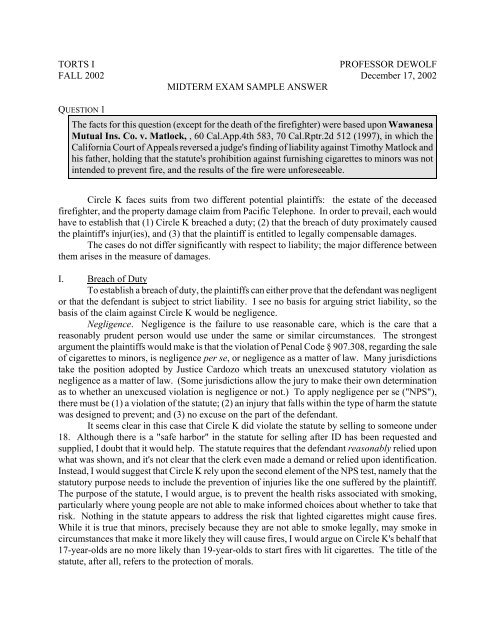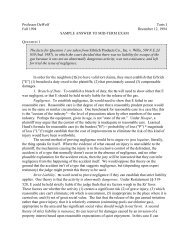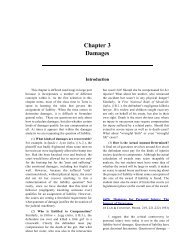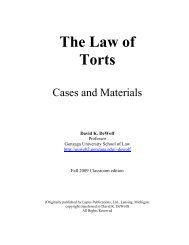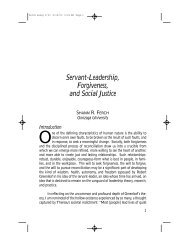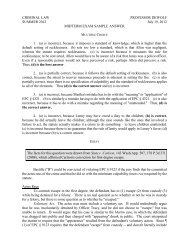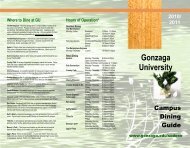were based upon Wawanesa Mutual Ins. Co. v. Matlock, , 60
were based upon Wawanesa Mutual Ins. Co. v. Matlock, , 60
were based upon Wawanesa Mutual Ins. Co. v. Matlock, , 60
Create successful ePaper yourself
Turn your PDF publications into a flip-book with our unique Google optimized e-Paper software.
TORTS I PROFESSOR DEWOLF<br />
FALL 2002 December 17, 2002<br />
MIDTERM EXAM SAMPLE ANSWER<br />
QUESTION 1<br />
The facts for this question (except for the death of the firefighter) <strong>were</strong> <strong>based</strong> <strong>upon</strong> <strong>Wawanesa</strong><br />
<strong>Mutual</strong> <strong>Ins</strong>. <strong>Co</strong>. v. <strong>Matlock</strong>, , <strong>60</strong> Cal.App.4th 583, 70 Cal.Rptr.2d 512 (1997), in which the<br />
California <strong>Co</strong>urt of Appeals reversed a judge's finding of liability against Timothy <strong>Matlock</strong> and<br />
his father, holding that the statute's prohibition against furnishing cigarettes to minors was not<br />
intended to prevent fire, and the results of the fire <strong>were</strong> unforeseeable.<br />
Circle K faces suits from two different potential plaintiffs: the estate of the deceased<br />
firefighter, and the property damage claim from Pacific Telephone. In order to prevail, each would<br />
have to establish that (1) Circle K breached a duty; (2) that the breach of duty proximately caused<br />
the plaintiff's injur(ies), and (3) that the plaintiff is entitled to legally compensable damages.<br />
The cases do not differ significantly with respect to liability; the major difference between<br />
them arises in the measure of damages.<br />
I. Breach of Duty<br />
To establish a breach of duty, the plaintiffs can either prove that the defendant was negligent<br />
or that the defendant is subject to strict liability. I see no basis for arguing strict liability, so the<br />
basis of the claim against Circle K would be negligence.<br />
Negligence. Negligence is the failure to use reasonable care, which is the care that a<br />
reasonably prudent person would use under the same or similar circumstances. The strongest<br />
argument the plaintiffs would make is that the violation of Penal <strong>Co</strong>de § 907.308, regarding the sale<br />
of cigarettes to minors, is negligence per se, or negligence as a matter of law. Many jurisdictions<br />
take the position adopted by Justice Cardozo which treats an unexcused statutory violation as<br />
negligence as a matter of law. (Some jurisdictions allow the jury to make their own determination<br />
as to whether an unexcused violation is negligence or not.) To apply negligence per se ("NPS"),<br />
there must be (1) a violation of the statute; (2) an injury that falls within the type of harm the statute<br />
was designed to prevent; and (3) no excuse on the part of the defendant.<br />
It seems clear in this case that Circle K did violate the statute by selling to someone under<br />
18. Although there is a "safe harbor" in the statute for selling after ID has been requested and<br />
supplied, I doubt that it would help. The statute requires that the defendant reasonably relied <strong>upon</strong><br />
what was shown, and it's not clear that the clerk even made a demand or relied <strong>upon</strong> identification.<br />
<strong>Ins</strong>tead, I would suggest that Circle K rely <strong>upon</strong> the second element of the NPS test, namely that the<br />
statutory purpose needs to include the prevention of injuries like the one suffered by the plaintiff.<br />
The purpose of the statute, I would argue, is to prevent the health risks associated with smoking,<br />
particularly where young people are not able to make informed choices about whether to take that<br />
risk. Nothing in the statute appears to address the risk that lighted cigarettes might cause fires.<br />
While it is true that minors, precisely because they are not able to smoke legally, may smoke in<br />
circumstances that make it more likely they will cause fires, I would argue on Circle K's behalf that<br />
17-year-olds are no more likely than 19-year-olds to start fires with lit cigarettes. The title of the<br />
statute, after all, refers to the protection of morals.
DeWolf, Torts I, Fall 2002, Midterm Sample Answer Page 2<br />
Even if we avoid the imposition of negligence per se, we might still be found negligent as<br />
a matter of fact, since a jury might, <strong>based</strong> on their own experience, decide that Circle K's methods<br />
<strong>were</strong> inadequate to satisfy the standard of reasonable care. Using the Learned Hand test, which<br />
compares the cost of preventative measures with the expected safety benefits from the burden of<br />
prevention, the cost of an ID check seems negligible in comparison to reducing the costs from teen<br />
smoking. Even if the teenagers used fake ID, the plaintiffs could argue that sophisticated ways of<br />
smoking out (so to speak) fake ID would be worth it.<br />
The plaintiffs might also benefit from any company policies relating to the sale of cigarettes;<br />
if employees <strong>were</strong> instructed on methods of checking IDs or had some other policy that was not<br />
followed, such disobedience could be used as strong evidence of negligence.<br />
II. Proximate Cause<br />
Even if the jury finds Circle K negligent, there is no liability unless that negligence<br />
proximately caused the injuries in question. To establish proximate cause, the plaintiffs must prove<br />
by a preponderance of the evidence that (1) but for the defendant's negligence, they would not have<br />
been injured; and (2) the defendant's negligence is also a legal cause of the injury. With respect to<br />
the first prong of the test, it seems clear that, without the cigarettes, there would have been no fire.<br />
By contrast, I don't think the plaintiffs can prevail with respect to legal cause. There are<br />
several difficulties. One is that, to constitute legal cause, the defendant's negligence must increase<br />
the risk of injury to the plaintiffs. Circle K could argue here that the sale of cigarettes to a 17-yearold,<br />
while illegal, did not actually increase the risk of injury from fire. But cigarettes do cause a lot<br />
of accidental fires, so I don't think that argument would work. A more plausible argument is that<br />
the negligence of Circle K was superseded by the negligence of the boys who chose to trespass, and<br />
engage in horseplay, which eventually led to the fire. The test for superseding causes is whether or<br />
not they are (1) so unforeseeable in type, and (2) so disproportionate in culpability that they break<br />
the chain of causation. In some cases involving a defense claim of superseding cause, the plaintiffs<br />
can argue that the statute supplies the degree of foreseeability to establish legal cause as a matter of<br />
law. I don't think that's the case here, for the same reason that I think a negligence per se argument<br />
is dubious; the statute's intent was probably limited to the prevention of disease from underage<br />
smoking, not accidental fires. Assuming the statute can't be used to supply legal cause, the plaintiffs<br />
might still argue that there <strong>were</strong> no superseding causes because the careless use of the cigarette is<br />
hardly unforeseeable, nor was any act by the boys (or the telephone company) so disproportionately<br />
reprehensible as to break the chain of causation between the defendant's negligence and the injury.<br />
The final and most promising argument for lack of legal cause is that the plaintiffs <strong>were</strong><br />
unforeseeable in the sense that Cardozo and Andrews discussed it in the famous Palsgraf case. In<br />
some jurisdictions (those following Cardozo) the defendant's duty is limited to those plaintiffs who<br />
are within the "zone of danger." The question would be, could a clerk in a convenience store<br />
reasonably foresee that a sale of cigarettes to minors would lead to a fire, causing the collapse of a<br />
logpile and the death of a firefighter called to the scene? I don't think so. On the other hand, some<br />
jurisdictions use Judge Andrews' test, which does not limit the scope of negligence, but restricts<br />
recovery to those injuries which can be said to have been proximately caused by the defendant's<br />
negligence. Andrews' test was more flexible, but a judge or jury applying this test would still be<br />
troubled by the number of twists and turns in the fact pattern leading to the ultimate injuries. It<br />
would be a jury question, but probably a tough sell for the plaintiff(s).
DeWolf, Torts I, Fall 2002, Midterm Sample Answer Page 3<br />
III. Damages<br />
There are two different types of damages here, reflecting the different plaintiffs. The<br />
property damage claim made by Pacific Telephone would be measured by the diminution in the fair<br />
market value of the logs (or other property) before and after the fire.<br />
The claim for Perry's death would be more complex. The first question is who is eligible to<br />
collect the wrongful death damages. Under the statute, the benefits are limited to a spouse, parents,<br />
or children. There do not appear to be any. Sarah in particular does not qualify, although despite<br />
the statement that P was "single," and an engagement that reflects their own belief that they <strong>were</strong><br />
not married, perhaps they in fact met the standard for common law marriage. It's a very long shot,<br />
but I'd want to verify that S is not P's spouse.<br />
Moreover, the only damages permitted by the statute are pecuniary damages, which are<br />
usually interpreted to mean economic loss. Since there is (apparently) no one qualified to recover<br />
loss from Perry's death, again there would be no recovery. If Sarah <strong>were</strong> qualified as a common law<br />
spouse, she would be limited to lost wages, rather than any kind of pain and suffering or loss of<br />
consortium benefits.<br />
There is a provision in the statute for recovery of funeral and medical care expenses if no one<br />
is qualified to recover for the economic loss. If Perry had lingered, this could be a substantial sum,<br />
but since he died at the scene it looks like the only damages will be the cost of a funeral.<br />
It's conceivable that Sarah or some other person suffered a bystander injury from watching<br />
Perry die in the fire. Typically courts employ some version of the three-pronged test in Dillon v.<br />
Legg: (1) was the plaintiff at the accident scene; (2) did he or she suffer a direct emotional impact<br />
from observing the tragedy; and (3) <strong>were</strong> the plaintiff and the victim closely related? I doubt that<br />
any of the firefighters would qualify, and there's no suggestion that Sarah was at the scene of the<br />
accident. If she came shortly after the accident, before there had been a material change in the<br />
scene, she might have a claim, but that's speculative.<br />
QUESTION 2<br />
This case is loosely <strong>based</strong> on the facts in Fifer v. Dix, 2000 Wis.2d 66, <strong>60</strong>8 N.W.2d 740<br />
(2000), in which the court reversed a summary judgment in favor of the dog owner, holding that<br />
the plaintiff had a statutory claim for strict liability, but failed to establish any negligence.<br />
Fifer should consider tort claims against both Dix and Kappel. In order to prevail, Fifer<br />
would have to establish (1) a breach of duty that (2) proximately caused (3) his damages.<br />
I. Breach of Duty<br />
A breach of duty can be established in two ways: first, Fifer could establish that either Dix<br />
or Kappel was negligent in their handling of Zippy; or he could try to show that one or both is<br />
strictly liable for Zippy's behavior.<br />
Negligence. Both Dix and Kappel would be under an obligation to use reasonable care in<br />
their handling of Zippy. Fifer might allege that Dix and/or Kappel failed to use reasonable care, and<br />
therefore should be found negligent. I don't know how promising this argument would be. It seems<br />
likely that the jurors, many of whom own dogs, and perhaps hunt, would exercise their own<br />
judgment about this matter, and would likely see Dix and Kappel as behaving reasonably in simply<br />
warning about Zippy's dangerous tendencies. On the other hand, the jury might think that either
DeWolf, Torts I, Fall 2002, Midterm Sample Answer Page 4<br />
Kappel or Dix was lax in choosing such a dog in the first place, or in failing to take more precautions<br />
in handling him so that he would not cause injury to someone else. The case would be much<br />
stronger if the victim <strong>were</strong> not on notice of the dog's dangerous potential, 1 but perhaps the jury<br />
would find that even in these circumstances either or both of the defendants acted negligently, since<br />
Fifer only found out about the dog's characteristics once they <strong>were</strong> en route.<br />
Strict Liability. The more difficult question is whether Kappel, or more likely Dix, can be<br />
held strictly liable for the dogbite. Under the the traditional rule, owners of dangerous animals are<br />
strictly liable for injuries they cause. This rule applies either to animals vicious by nature (e.g.,<br />
tigers), or to domestic animals like dogs after the owner is put on notice of the dog's tendency to<br />
bite. (Hence the misleading aphorism that "every dog gets one bite"). In this case, Zippy had<br />
previously bitten someone, and each defendant knew about that capacity. Moreover, the statute is<br />
even stronger than the common law, making the owner strictly liable even before the first bite.<br />
The problem for the case against Kappel is that he is not the owner of the dog, although he<br />
had temporary custody of the dog. I don't think that would be enough, but it's something to be<br />
explored with further research into previous interpretations of the statute. Dix, on the other hand,<br />
is the owner of the dog, and Fifer might be able to rely on the principle that Dix kept the dog at his<br />
peril. Again, this reading of the statute seems a little harsh given Dix's transfer of custody of the dog<br />
to Kappel, but strict liability is, after all, strict.<br />
The statute lends support to a strict interpretation, since there is liability under § (1)(a) even<br />
where the owner has no reason (<strong>based</strong> on prior experience) to think the dog would bite someone.<br />
Where, as here, the owner is on notice, the damages are doubled (§ 174.02(1)(b)). This seems to<br />
suggest that the statute was intended to make owners keep dogs at their peril, and Dix's lack of fault<br />
in a traditional sense would be unavailing.<br />
II. Proximate Cause<br />
Proximate cause requires proof of (1) but-for causation; and (2) legal cause. I don't see any<br />
issue with but-for causation. The negligence claims would be <strong>based</strong> <strong>upon</strong> a failure to take a<br />
precaution (like leaving the dog at home, or putting a muzzle on him) that, if taken, would have<br />
prevented the injury. It's conceivable that Dix would argue that Kappel was a superseding cause of<br />
the injury, but that is implausible. To be a superseding cause, Kappel would have to do something<br />
unforeseeable, and in this case he was merely doing what he said he would do when he borrowed<br />
Zippy.<br />
III. Damages<br />
Damages for Fifer would consist of (1) economic loss—in the form of wage loss and medical<br />
expense; plus (2) pain and suffering; plus (3) potential doubling of the award.<br />
The economic loss would be measured by past wage loss, plus the difference between what<br />
Fifer would have been able to earn and what he will now be able to earn because of the loss of use<br />
of his hand. Probably an expert economist would be employed to calculate the wage differential and<br />
reduce it to present value. There would also be medical costs, both those already incurred in treating<br />
his injury, and perhaps future medical expenses to deal with the nerve damage.<br />
1. If this <strong>were</strong> not a first semester test, in which the instructions limit your analysis to the scope<br />
of what was covered in the first semester, it would be very relevant to consider the likely argument<br />
from the defense that Fifer was either contributorily negligent or assumed the risk.
DeWolf, Torts I, Fall 2002, Midterm Sample Answer Page 5<br />
Pain and suffering damages would include not only the physical pain, but also the emotional<br />
effects of losing manual dexterity for common activities.<br />
Although punitive damages in the traditional sense would seem inappropriate, since Dix was<br />
loaning the dog as an accommodation to his friend, and he did his best to warn about the dog's<br />
nature, the statute does seem clear in imposing double damages when the owner has knowledge, so<br />
we would certainly ask the court to take the ordinary compensatory award and double it, per the<br />
statute.
G Overview<br />
G Breach of Duty<br />
G (No strict liability)<br />
G Negligence Claim<br />
G Negligence defined as failure to use RC<br />
G Negligence per se<br />
G Jurisdictional variants explained<br />
G Elements of negligence per se<br />
G Statute was probably violated<br />
G Excuse/defense for checking ID?<br />
G Purpose of the statute?<br />
G Are minors greater fire risks?<br />
G<br />
G Negligence in Fact<br />
G Juror Experience<br />
G Learned Hand test for ID check<br />
G Rulebook violation?<br />
G Proximate Cause defined<br />
G But-for test satisfied<br />
G Legal Cause more difficult<br />
G Mere chance vs. increased risk<br />
G Superseding tortfeasor<br />
G Statute prob. doesn't supply legal cause<br />
G<br />
G Overview<br />
G Claim v. Dix<br />
G Negligence Claim<br />
G Negligence defined as lack of RC<br />
G Juror Experience with dogs<br />
G<br />
G Claim <strong>based</strong> on strict liability<br />
G Traditional rule of SL after notice<br />
G Statutory modification<br />
G Did the legislature intend true SL?<br />
G Claim v. Kappel<br />
G Probably not the owner, so no SL<br />
G Was Kappel Negligent?<br />
G<br />
G No Proximate Cause issues<br />
G Kappel not a superseding tortfeasor<br />
G Kappel probably not even negligent<br />
Fall 2002 Torts Midterm Checklist<br />
QUESTION 1<br />
G Foreseeability of subsequent harm?<br />
G Subsequent act not disproportionately culpable<br />
G Palsgraf issue<br />
G Cardozo: was firefighter in zone of danger?<br />
G Andrews: did neg. proximately cause injury?<br />
G<br />
G Damages<br />
G Property damage for Pacific Telephone<br />
G Measured by diminution in FMV<br />
G<br />
G Wrongful Death claim<br />
G Statute limits recovery to pecuniary damages<br />
G Perry left no spouse, parents, or children<br />
G Recovery for funeral if no qualified beneficiary<br />
G Bystander claim?<br />
G Dillon test for bystanders<br />
G<br />
G<br />
G<br />
G<br />
QUESTION 2<br />
G Damages<br />
G Economic loss<br />
G Calculation of future wages<br />
G Medical expenses<br />
G Pain & suffering<br />
G Loss of Use<br />
G<br />
G No traditional punitive damages<br />
G Doubling per statute<br />
G<br />
G<br />
G<br />
G<br />
G<br />
G<br />
G<br />
Exam # _______________________


